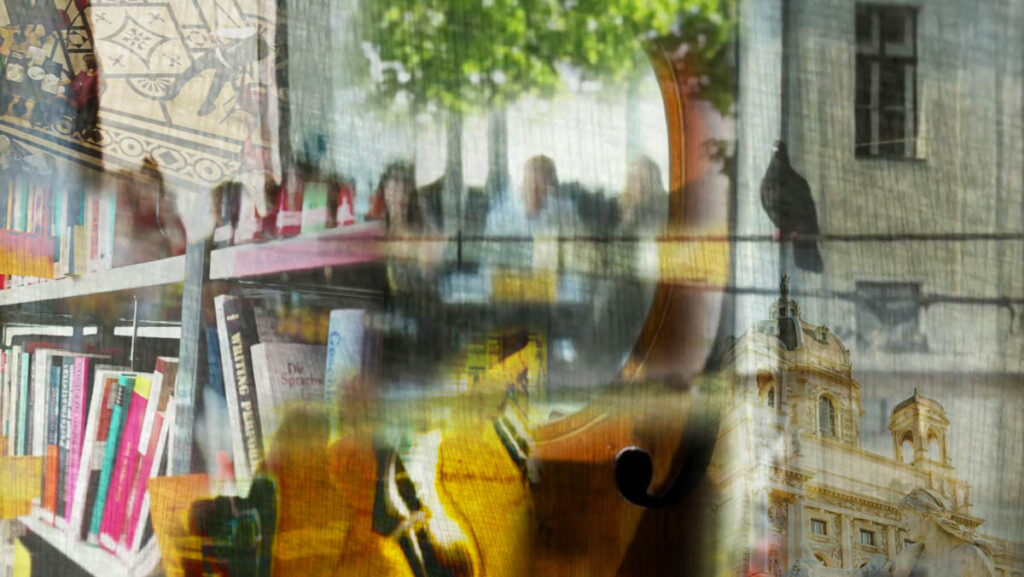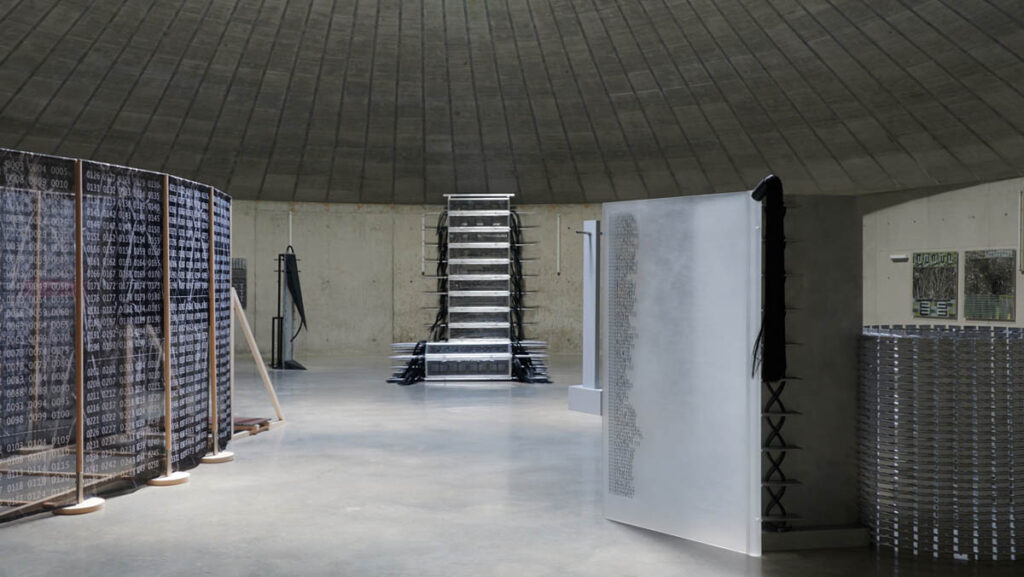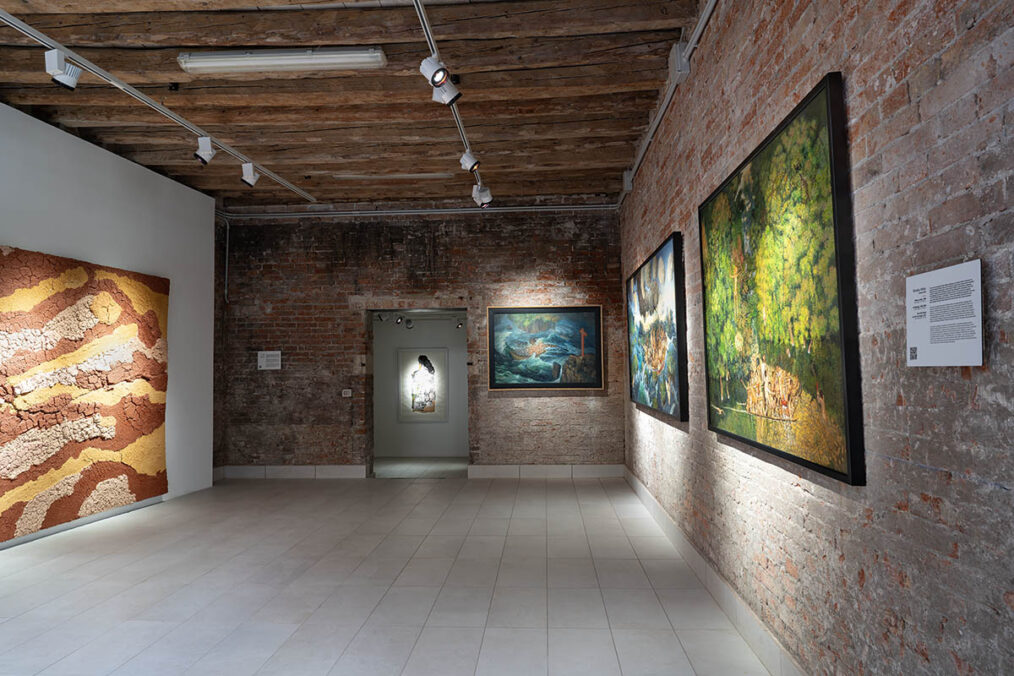
In an interview with Ana Elizabeth Gonzalez, one of the three curators of the pavilion, we gain an insight into the focus of this impressive exhibition.
How do you go about selecting artists and artworks?
Curator, Ana Elizabeth Gonzalez: When we received the endorsement of the Ministry of Culture to curate the first Panama Pavilion, we created a curatorial commission composed of myself, Dr. Mónica Kupfer, and Luz Bonadies. We selected the artists based on their trajectory and body of work, but mostly because they had been researching the themes we explored in the curatorial concept. All the works were commissioned for the pavilion, except for Brooke Alfaro’s paintings, which we thought enriched the dialogue between them.
When did the artists first meet?
AEG: The artists have known each other for a long time in their careers; Panama’s art sector is small, so they have been acquainted with each other.
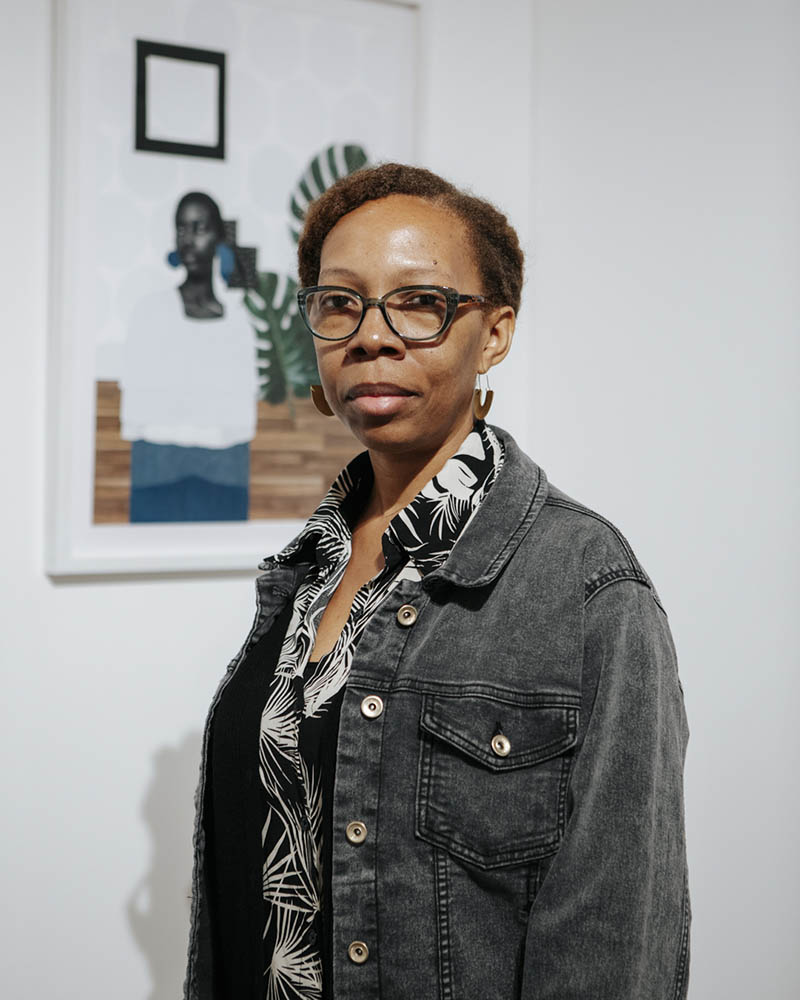
How does your heritage influence your artistic exploration of themes related to migration, identity, and cultural diversity?
Giana de Dier: My maternal great-grandparents migrated from Barbados to Panama in the early 1900s during the construction of the Panama Canal. Like so many people at that time, they were also searching for better opportunities for themselves. This event and the stories I’ve heard about my great-grandmother inform my college practice and how I approach personal and institutional archives. Much of my interest is in humanizing the migratory experience by highlighting women’s stories, most of which have been excluded from the major conversation. I’m also interested in how archives shape how we understand events from that time and how that information can be reimagined.
How do you see your role as an artist?
GdD: Most days, my role as an artist is that of a communicator and interpreter. How I see and understand the world transforms the information I find. My intention is not to change history but to present alternatives to what is usually shown, hopefully holding space for others to ask questions and question what they think they know about the themes I’m exploring.
Can you share any personal experiences that have informed your artwork?
GdD: My great-grandmother used to be a laundress in Panama City, washing U.S. soldiers‘ uniforms to have an additional income for the household. With that job, she saved enough for their home, which is still in my family. She was the one who visited the property, met with the real estate agent, and decided which house would be bought. Hearing this made me think of other stories of Afro-Caribbean women waiting to be explored. Although it was not unusual for Afro-Caribbean women to make family decisions just like their partners, it felt like an amazing story, considering it was happening in a country foreign to her. That way, she navigated the space and negotiated payments, and her resourcefulness will always inspire my work.
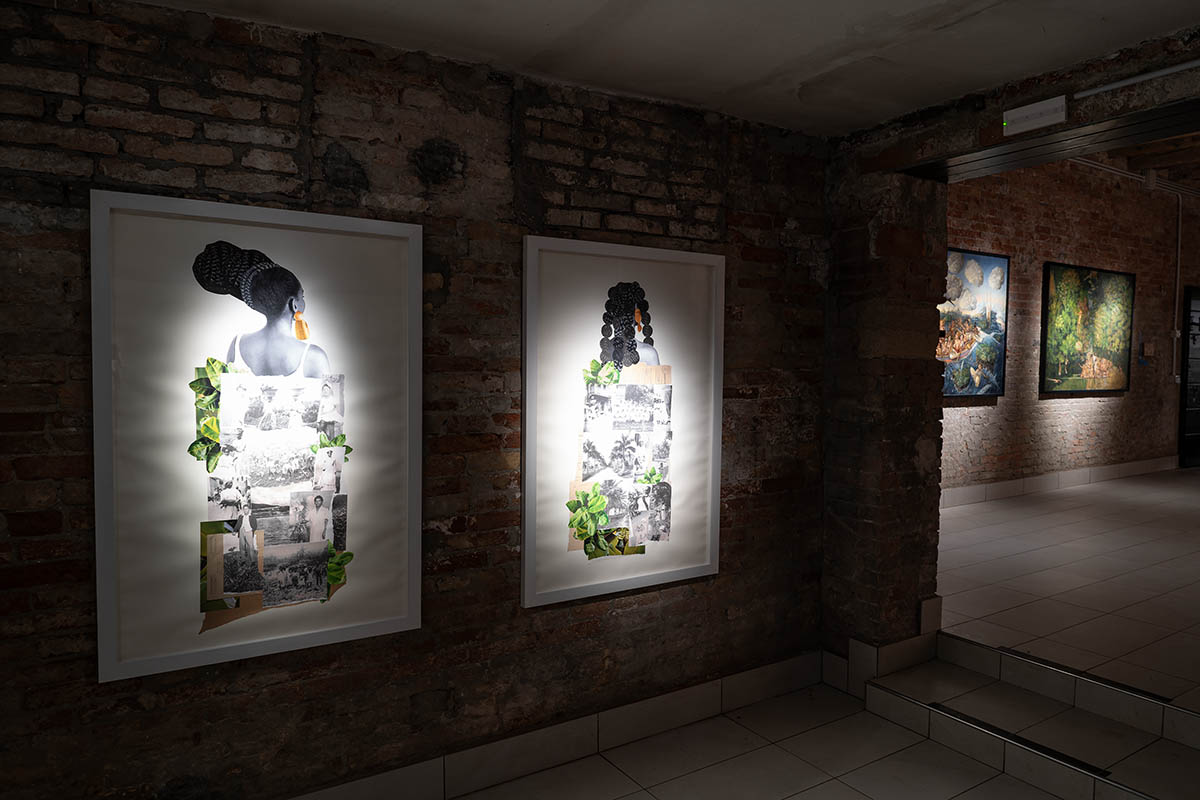
How do you choose the images or elements that you integrate into your collages?
GdD: Most of the images I choose to work with show women’s everyday lives and images that depict or can be made to show what life was like in the late 19th and early 20th century in the Caribbean and Panama. Because photographic archives for the construction of the Panama Canal are limited in the number of women photographed, I tend to use photos from any part of the African Diaspora, trying to find similarities or parallels between the experiences shown and those I’m trying to reimagine.
How did your recent visit to the jungles of Darien influence the creation of this installation?
Isabel de Obaldia: The phenomenon of migrants going through the Darien gap has been on my mind for a couple of years. I presented a proposal about this theme last year to La Maison de l’Amerique Latine in Paris, and they have offered me an exhibition for the fall of 2025. I have been working on several ideas for this coming exhibition.
I was very excited when the curators of the Panama Pavilion invited me to be one of the artists for the Biennale. Since time was short, I decided to focus on one simple statement. I knew for certain that I wanted to convey the Darien jungle’s beauty in contrast to migration’s perils. I went there and spent a few days drawing, taking photographs, listening to people’s first-hand stories, and trying to get a sense of all the complexities happening in this area.
Darien has always been no man’s land. It is also the corridor of the jaguar, a haven for wild animals to travel between Central and South America.
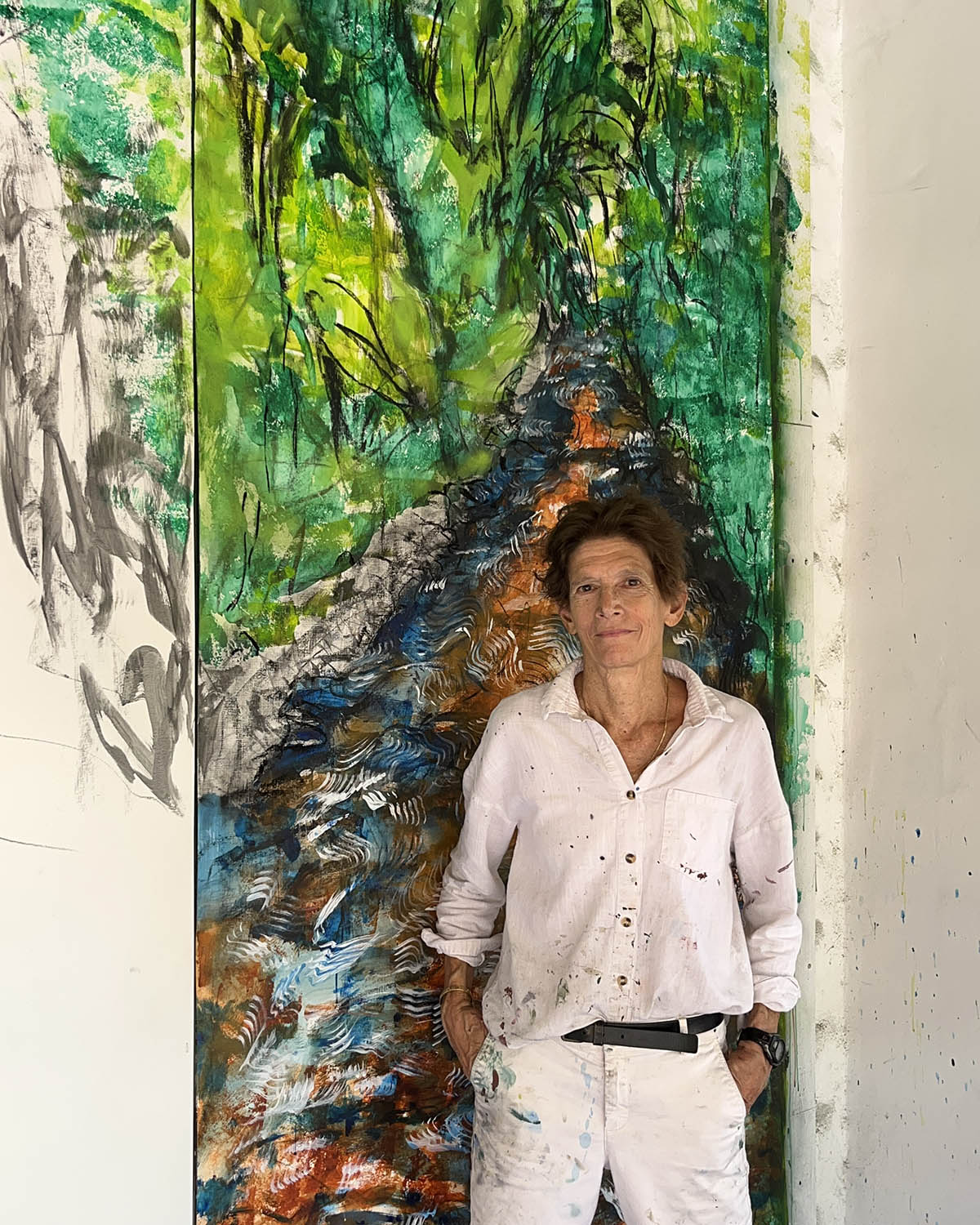
Glass figures, sound effects, and mixed-media drawings are intriguing elements to incorporate into your installation. Could you elaborate on how each of these components contributes to the overall narrative or message you wish to convey about migration and its effects?
IdO: I have been making glass sculptures for more than 30 years and drawing since early adolescence. Using these mediums for my installation seemed natural. Sound is a relatively new element for me. I have recently discovered that I enjoy the mixing and editing of sounds to create a story. For this installation, I knew I wanted to incorporate some of the sounds that I had recorded while in the jungle. At first, I was reluctant to incorporate the voices of the migrants out of respect for their privacy, but as I was putting the track together, I realized it needed a human element that would tie the glass figures to the drawings and would also convey the pain and fear each one of these individuals must be going through as they make this infernal journey.
How do you navigate representing such a complex and widespread phenomenon in your artistic practice?
IdO: I have been working on and thinking about this theme for quite some time. I am not a documentarian and did not want to make a realistic statement about this issue. There is already plenty in the news. I believe that by creating a more open and poetic piece, I could evoke the hardships endured every day by migrants in general.
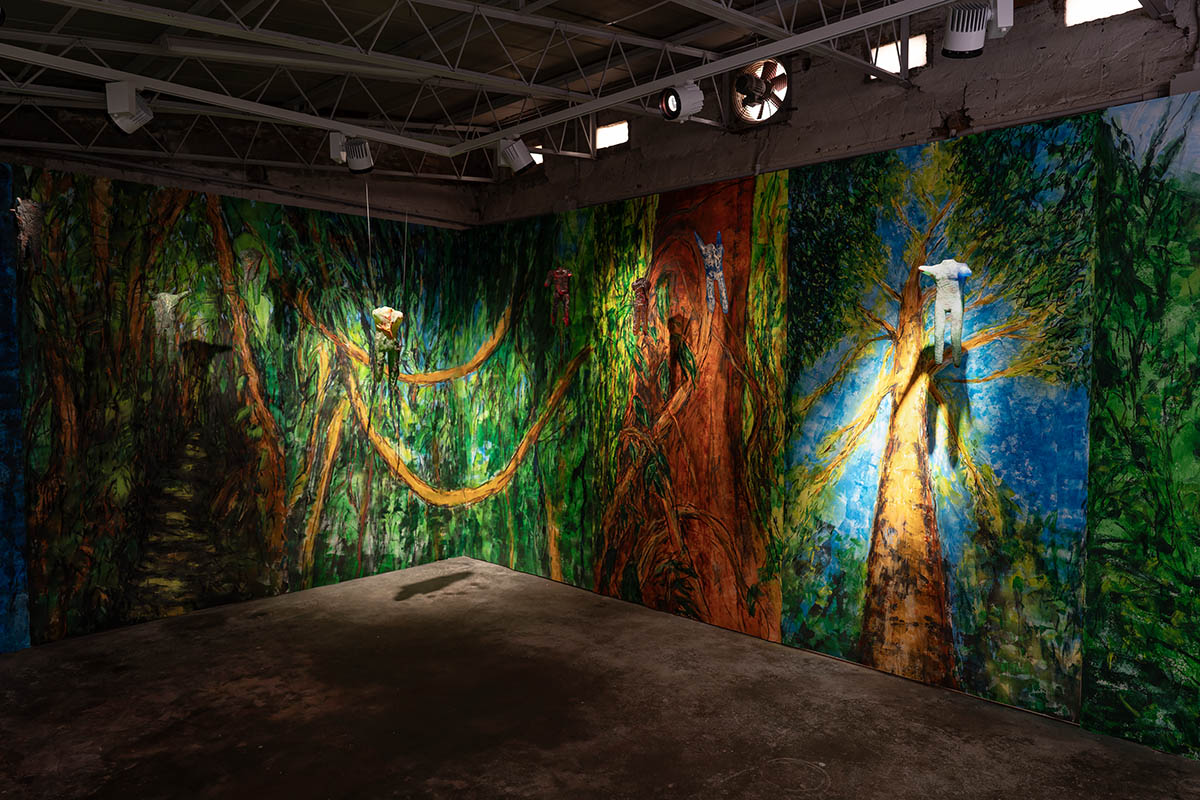
I made large drawings concerning some of the places I had seen in Darien. I wanted to immerse the viewer in its beauty. In contrast, the cast-glass figures are small, as one feels when walking in the immensity of the jungle. The uncertainty of the unknown. Each one of the figures has individual markings, creating their own story. The lighting was also essential. The shadows of the sculptures reflect on the drawings. There is darkness from the fog, but also pockets of light when the sun shines through.
The fact that these figures are hanging and therefore have an almost imperceptible movement is also important to me. I feel that, in general, we are going through such uncertain times that we could be said to be standing still but swaying. Waiting in time. The pendulum paradox.
Are there specific emotions or reflections you aim to evoke?
IdO: I hope to evoke the hardships that all individuals go through as they journey in search of a better life. I respect their courage and feel compassion for what they are going through.
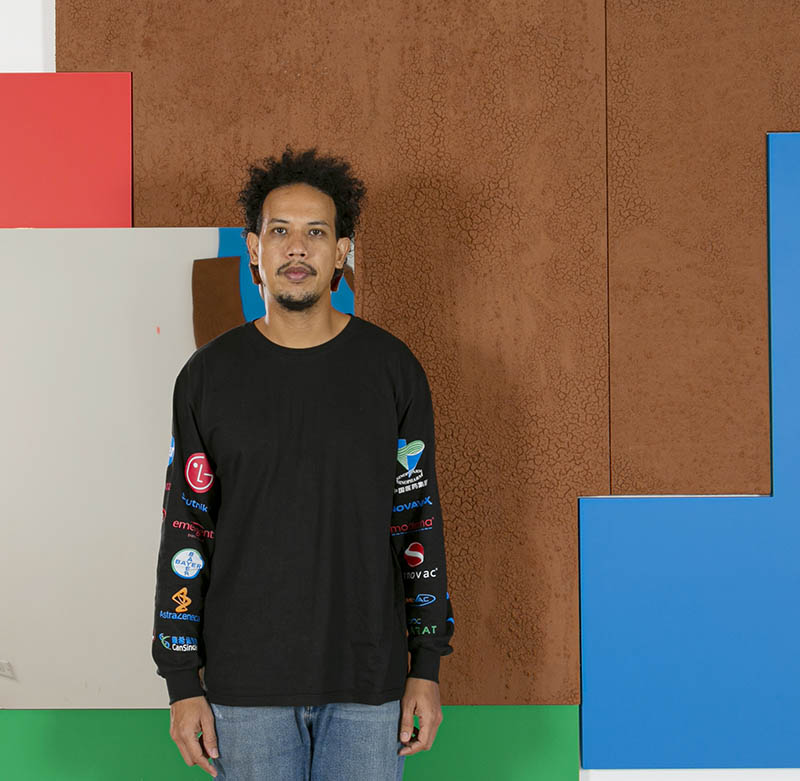
Could you elaborate on how you investigate and represent these origins in your art and why you find them compelling subjects for exploration?
Cisco Merel: Panama stands out for being a place full of contrasts and enriched by influences from around the world due to its migratory history linked to the canal. I am Afro-Chinese Panamanian—a mixture, the product of all this rich cultural diversity that emerges from this reality, directly shaping my work. My main sources of exploration come from popular art, Afro-Antillean architecture, migration, and street life. Color, treated as a theme of empowerment and a sense of belonging, plays an essential role in my work.
Who are your influences? Are there specific aspects of Panamanian culture or society that you find particularly inspiring or challenging to address in your art?
I observe how architecture and customs intertwine and merge over time, generating a unique blend. Color becomes a crucial tool for appropriating these inherited structures, endowing them with identity and meaning. My creative process begins by dissecting historical themes or references to create a vocabulary. I use abstraction to explore a variety of topics, employing visual references from architecture, photography, and my immediate surroundings. Over time, I have come to understand that my exploration of forms goes beyond creative expression; it is a way to communicate the themes that interest me, such as social contrast, migration, and urban landscape and its symbolic significance.
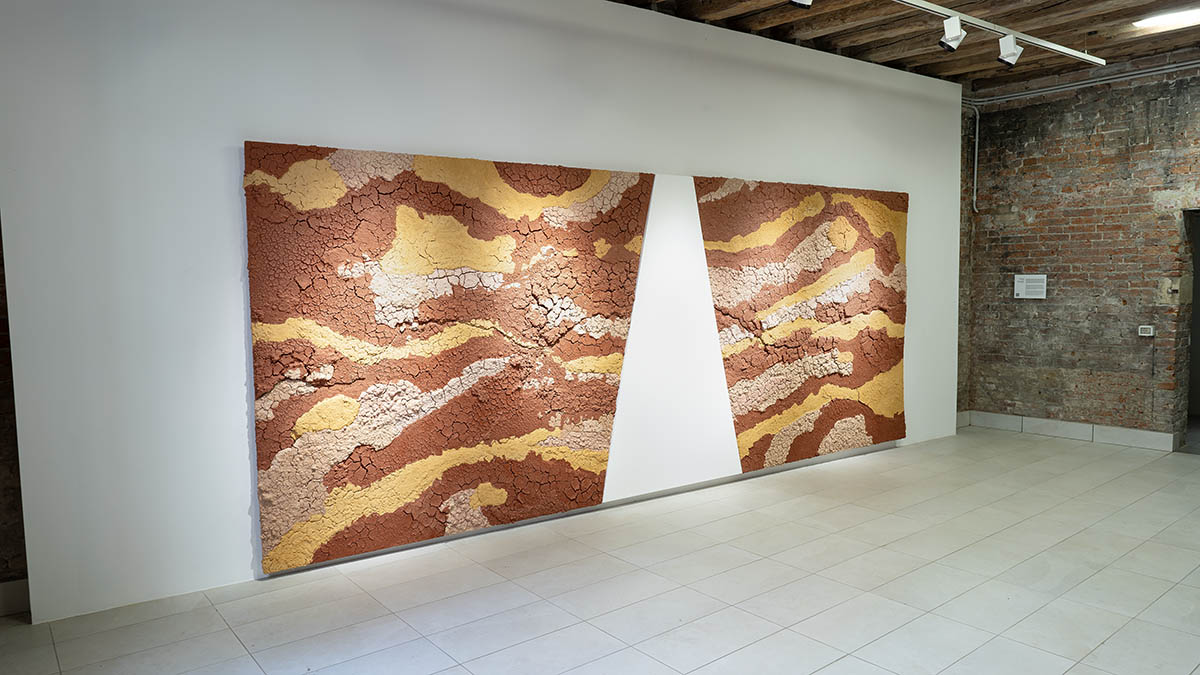
Tell me more about „Mirages of the Gap“.
For me, it is an honor to participate in this edition of the Venice Biennale, Panama participates for the first time in the history of the biennial, along with colleagues and masters whose work I deeply appreciate: Isabel de Obaldia, Brooke Alfaro, and Giana de Dier. My work specifically addresses the Darién Gap and everything that happens on the border between Panama and Colombia. It focuses on the illusion of crossing and the complexity involved in crossing one of the most dangerous jungles in the world.
The artwork „Mirages of the Gap“ metaphorically explores the journey migrants make through the thick and roadless rainforest known as the Darien Gap. Based on two large abstract structures in which layers of mud have replaced paint and pigment, the rough textures of the multicolored soil that the artist gathered on-site symbolize the arduousness of the earthy trails that human beings have carved through the jungle. The structures converge on a central white wedge, an ascending triangle suggestive of a passageway with an unknown climax. The work emerges as an expression of awareness regarding both the collective journey and an individual sense of yearning, offering a visual and poetic testament to courage, resilience, and hope, encapsulating the essence of the human struggle for a better future and a more dignified way of life.
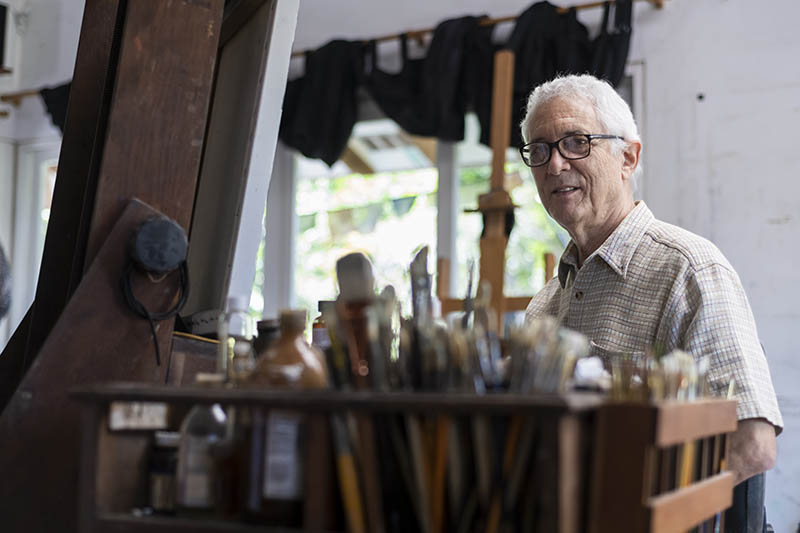
How has your background influenced your artistic practice?
Brooke Alfaro: As a young boy in school, I tended towards the arts, winning a few art competitions along the way, but being an artist was never on my menu until my 30s. I became an architect, worked, and then did some paintings intending to get them out of my system, but I liked them, quit work, and went on to study painting at the Art Students League in New York. I never stopped.
My mother painted in college, and on my paternal side of the family, there were many amateur artists; some became well-known. Both my parents had a good taste for art and enjoyed museums when traveling. It rubbed off.
Panama is a small, rather unique, third-world, and surrealistic society. In my youth, much of the country’s land and sea were pristine and undeveloped, and I, having a thirst for adventure, got to live it. The surreal still exists, but the country’s natural environment is quickly eroding. I enjoyed the outdoors more than socializing, but I always felt at home and at ease with country folks, low on the socioeconomic scale but rich in spirit and full of generosity.
As a „young“ artist returning to Panama to work, I didn’t have to look far to find my artistic expression or my path; it was its people and the natural environment. And ever since, my subjects have mainly been the simple folds, the working class, and those who struggle in an unjust world. The settings of my paintings are surreal, as is my country. This surrealism is widely portrayed in Latin American literature, referred to as magical realism. I feel an affinity for this. Maybe my work is my way to denounce this disparity; maybe it is a way to make my subjects visible; maybe it’s an excuse to paint something I find interesting and meaningful; maybe it is a way to shock. I don’t give too much thought to this; I just fall into it comfortably. This becomes more evident in my video work, where my subjects are the homeless with drug addiction, low-end prostitutes, gang members, etc.
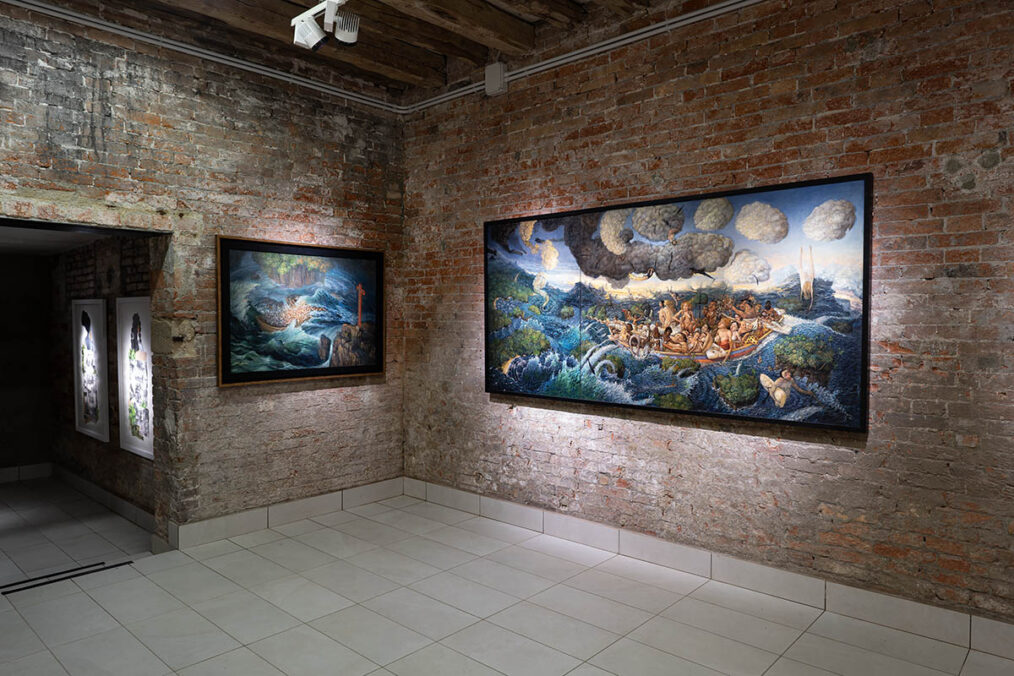
What works are you presenting in the Pavilion?
BA: I am showing three oil paintings ranging in date from 1997 to 2004. The three paintings are of boats full of people in precarious situations. They are intended to elicit an emotion from the spectator, whom I expect will create their storyline from their own life experiences. An explanation of my method: I don’t have a clear idea of how the painting will end up looking; I start to paint, and how it ends is usually disparate from where I started. The painting speaks to me; every new line and stroke evokes the next. I remove content as quickly as I place it. This, I confess, is a bit torturous, but it is the only way for me to stay true. There does come a moment in the advanced stages when a sensible narrative starts to emerge, and I follow it.
If I were asked to interpret these paintings, well, they evoke a longing for survival—to reach a destination before coming apart. It exemplifies our humanity; there is violence, religion, sex, hope, humor, insanity, and all that fun stuff. I say fun because this is what evokes me to paint, what motivates me, and where I find satisfaction.
And the reality portrayed within these paintings is, in a significant way, everyday life, as it has been historically. These boats, in some way, are reminiscent of people struggling, existing, and navigating towards a better, or maybe uncertain, future.
How do you see the intersection between art and activism?
Through my work, I am reflecting on the hardships of the human condition—maybe it is to make them visible. Since my college years, I have chosen it as my civic duty to work towards safeguarding our natural environment. I dedicate much time to this end. It is reflected in my paintings, many of which are landscapes and seascapes; sometimes these are tumultuous as if showing anger, making their feelings known. I see my activism as a fight against the system; my paintings, in a way, are on the edge between beauty and the grotesque. As I portray the beauty, strength, and fury of the natural world, I am also paying attention to composition, color, movement, and striving for balance and harmony in form. In my activism, I am also trying to protect and mend, but I am mostly hoping to make visible the damage being caused in the hopes of creating change. My greatest satisfaction with my paintings is for them to have a lasting effect on the viewer.
We live in a rather chaotic world, and for change to happen, there needs to be awareness. Activism fosters awareness; a painting can also do the same.
Tell me more about your activism work focusing on education and ecology.
I have founded several urban and environmental NGOs and served as the president of the board for many of them. For instance, I am the founder and current chairman of the Centro de Incidencia Ambiental (CIAM), established in 2007. It is composed of biologists and lawyers who litigate against infractions of our environmental laws. We defend our human right to a healthy environment; we advocate for the preservation of wetlands and protect biodiversity; we defend our marine ecosystems; and more. Recently, CIAM played a key role in achieving a national moratorium for open-air metallic mining.
I also feel that education is a catalyst for change. I was one of six founding members and board members of the Metropolitan School of Panama, now one of Panama’s most reputable international schools. Our academic program is International Baccalaureate Continuum Education. On a side note, we made great efforts to emphasize the arts, bringing music, visual arts, and theater into the curriculum in a meaningful way. For example, our students from 1st to 6th grades have two hours a week of music; they would choose an instrument (violin, viola, cello, base), learn to play and read music, and in middle school it was an elective. Same for visual arts and drama. Off and on, I have been a painting professor, both privately and at the Panama National University.
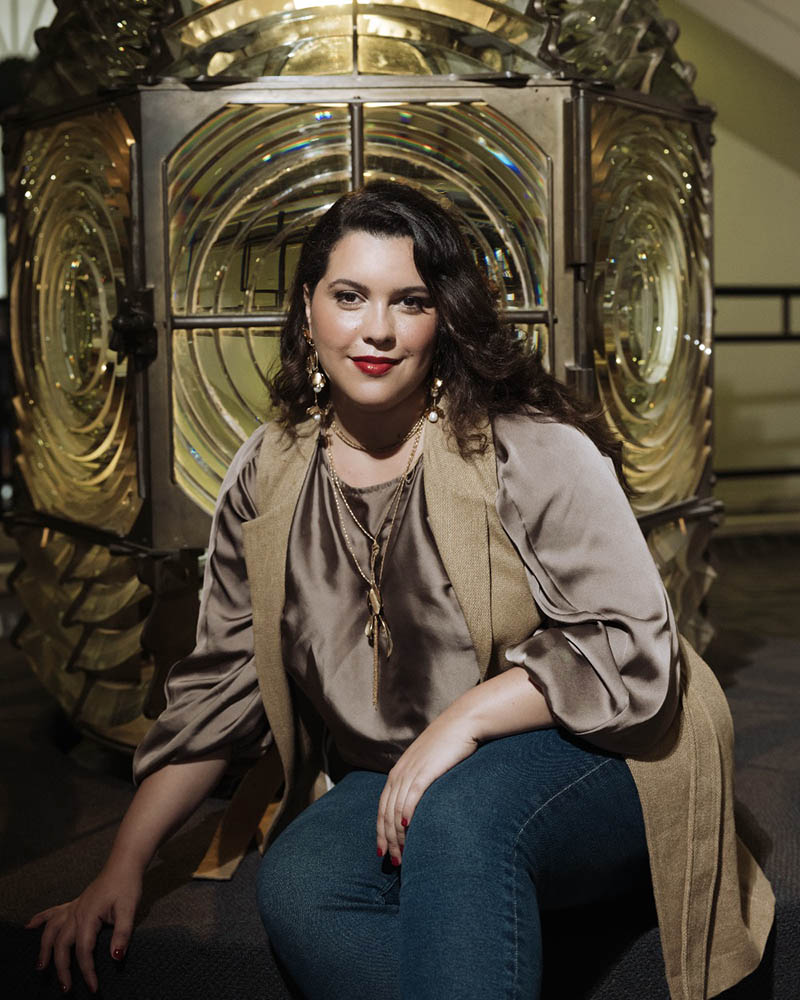
How did the collaboration unfold?
Curator, AEG: It has been a wonderful experience for all to be able to work together to make this first national pavilion a reality. There has been a huge team working towards this, and we could not be more honored and prouder of the results. We hope it sets the foundations for the country’s future participation in the biennale.
What was the biggest challenge?
Curator, AEG: Fundraising to make this pavilion a reality while working on its curation and logistics was the biggest challenge.
Will there be any additional events surrounding the exhibition?
Curator, AEG: We will have further activities and talks (virtually and in Panama); additionally, we will have an exhibition of the pavilion and its works at the Panama Canal Museum in 2025.
Exhibition: Tracce: Nel Corpo e sulla Terra
Artists: Brooke Alfaro, Isabel De Obaldia, Giana De Dier, Cisco Merel
Curators: Ana Elizabeth Gonzalez, Monica Kupfer, Luz Bonadies
Duration: 20th April – 24th November 2024
Panama Pavilion Location: Calle S. Biasio, 2131, 30122 Venezia VE, Italy
Panama Pavilion – www.panamapavilion.org, www.instagram.com/panamapavilion/



